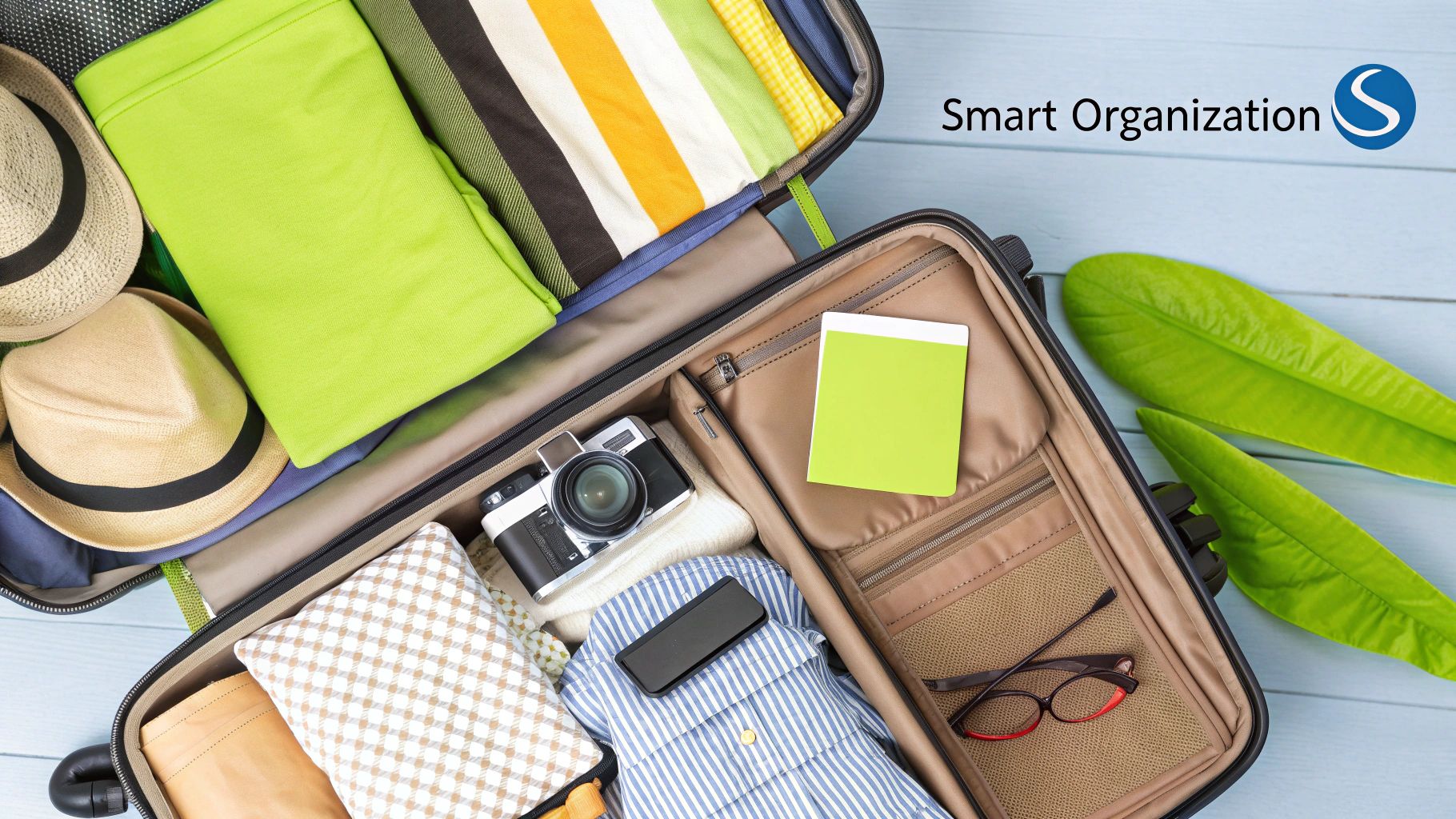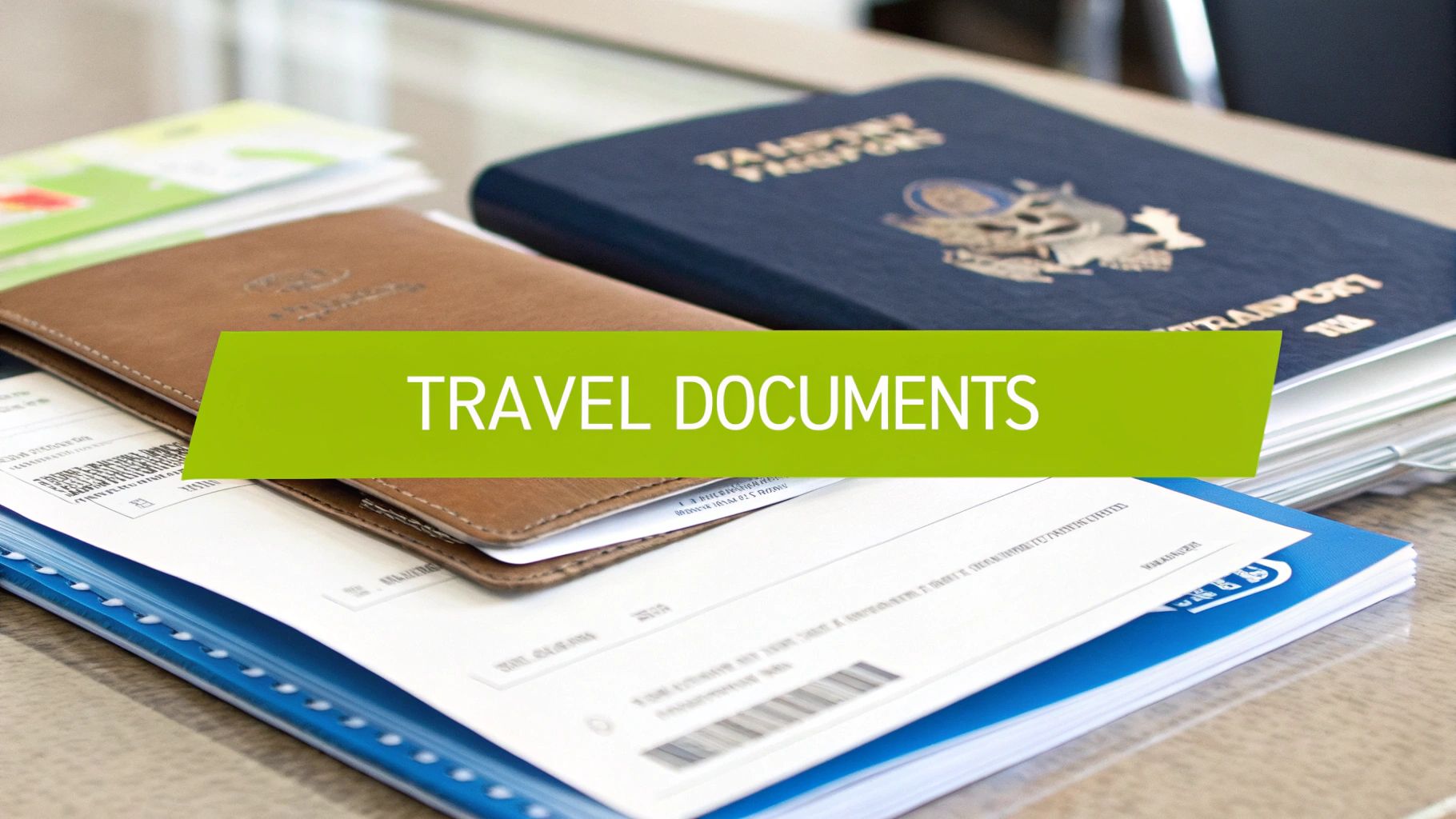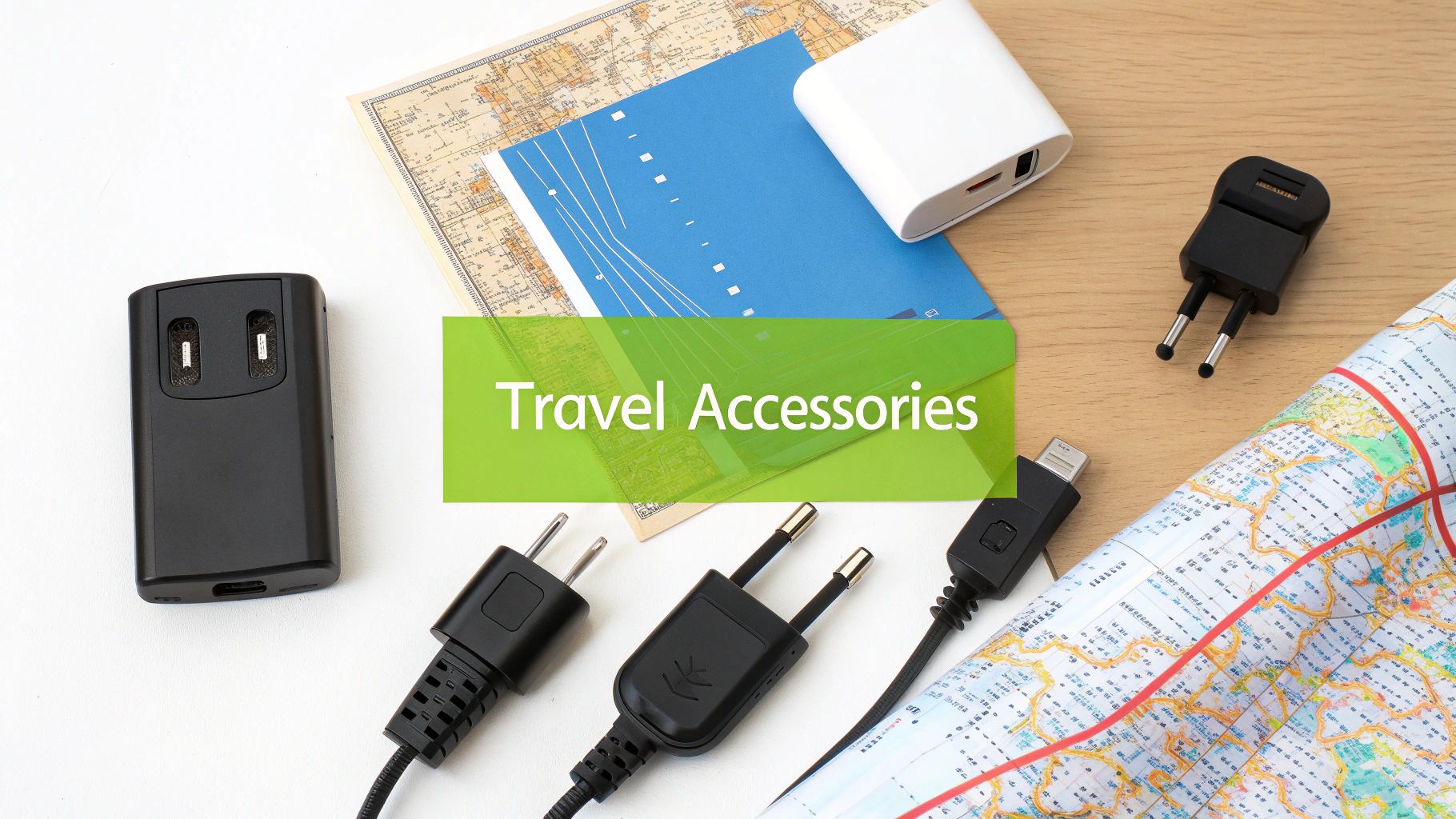Creating Your Perfect International Packing Strategy

Packing for a trip abroad can seem overwhelming. But with a solid plan, you can transform the experience from chaotic to calm. It all begins with a personalized packing list – your personal guide to stress-free travel. This list isn't meant to be static; instead, it should evolve and adapt to the specific needs of each trip.
Building Your Personalized Packing List
First, consider the climate of your destination. Are you traveling to a tropical beach, a vibrant European city, or a secluded mountain retreat? Each location demands a different wardrobe. Lightweight, breathable fabrics are key for warm weather, while layers are essential for unpredictable climates.
Also, think about the activities you'll be doing. Hiking boots are a must for rugged trails, but comfortable walking shoes are best for city exploration.
Next, think about your accommodations. Will your hotel provide toiletries like shampoo and conditioner, or will you need to pack your own? Some places offer laundry facilities, which can greatly influence how much clothing you need. Considering these details will help you pack light and efficiently. Start by prioritizing your essentials: medications, important documents, and electronics. Packing lists are vital for many, with 72.9% of travelers creating one before a trip. This helps ensure they don't forget anything crucial. For more insights, check out these Travel Packing Statistics from Radical Storage.
Prioritizing & Categorizing for Efficiency
After compiling your list, categorize everything. You can group items by type (clothing, toiletries, electronics) or by function (day outfits, evening wear, hiking gear). This simple step makes finding things in your luggage much easier, preventing frantic searches. This organized approach is especially helpful when you're jet-lagged and unpacking in a dimly lit room.
Finally, separate your must-haves from your nice-to-haves. While that extra pair of shoes might be tempting, consider if you truly need them. Think about how often you'll actually wear each item and whether it's worth the space it takes up. By prioritizing carefully, you can avoid overpacking and keep your luggage manageable. These packing tips, along with thoughtful prioritization, create the foundation for a successful international packing strategy.
Navigating Cultural Dress Codes Like a Local

Packing your suitcase is just the first step in preparing for international travel. Understanding the cultural nuances of your destination, especially local customs and dress codes, is equally important. These cultural considerations can significantly impact how you are perceived and received. What's perfectly acceptable in one country might be considered disrespectful in another.
Researching Cultural Expectations
Before you even start thinking about outfits, take some time to research the cultural norms of your destination. Websites, travel blogs, and guidebooks can offer valuable insights into appropriate attire. Consider the time of year and any specific events you plan to attend, as these can also influence local dress expectations.
This pre-trip research will help you avoid unintentional fashion mishaps. Cultural norms significantly influence packing decisions. In fact, 70% of travelers consider the cultural ambiance of their destination when choosing outfits. Around 55% adjust their clothing choices specifically to adhere to local customs. For a deeper dive into this topic, check out this insightful article: Exploring the Impact of Cultural Norms on Your International Travel Packing Choices.
Building a Versatile Wardrobe
Packing light doesn't mean sacrificing style or cultural sensitivity. The key is to create a versatile wardrobe that can adapt to various situations. Choose neutral-colored clothing items that can be easily mixed and matched.
A simple black dress, for example, can be dressed up with a scarf and jewelry for an evening out. The same dress can be paired with a cardigan and comfortable shoes for daytime sightseeing. This approach maximizes your outfit options while keeping your luggage light.
Layering and Convertible Clothing
Layering is essential, especially when traveling to destinations with varying levels of conservatism. A lightweight scarf can be used to cover your shoulders when visiting religious sites, or even draped over your head as a sign of respect in certain cultures.
Convertible clothing, like pants that zip off into shorts, also offers valuable flexibility. These adaptable pieces allow you to adjust to changing weather conditions or dress code requirements without packing extra items.
To help you further visualize dress code expectations across different regions, take a look at the table below. It summarizes key considerations and recommendations for a variety of destinations.
Dress Code Considerations by Region
| Region | Dress Code Level | Specific Considerations | Recommended Items |
|---|---|---|---|
| Middle East | Conservative | Cover shoulders and knees, especially in religious sites. Women may be expected to cover their hair. | Long skirts or pants, loose-fitting tops, scarves |
| Southeast Asia | Generally modest, but varies by country | Cover shoulders and knees when visiting temples. | Lightweight, breathable clothing, scarves |
| Europe | Varies widely, generally more relaxed | Dress respectfully when visiting religious sites. Beachwear is generally only acceptable on beaches. | Comfortable shoes for walking, layers for varying weather |
| North America | Casual | Dress codes vary by specific venue. | Comfortable clothing appropriate for the climate |
This table offers a quick glance at general guidelines. Remember to research specific destinations for a more detailed understanding of local customs.
Common Fashion Missteps to Avoid
While every culture is unique, some general guidelines can help you avoid common fashion faux pas. In many cultures, it's considered respectful to cover your shoulders and knees when visiting religious sites. Additionally, avoid clothing with potentially offensive slogans or images.
By being mindful of these considerations, you can demonstrate respect for local traditions and ensure a more positive travel experience. Combining cultural sensitivity with a practical packing approach will help you navigate international travel with confidence and grace.
Choosing Luggage That Works With You, Not Against You

Your luggage is your trusty sidekick on any journey. Picking the right piece can dramatically improve your international travel experience. It's about more than just looks; consider navigating cobblestone streets, packed airports, and unpredictable weather. Experienced travelers often choose completely different luggage depending on their specific trip.
Destination, Transportation, and Trip Duration
First, think about where you're going. Are you hitting busy city streets or exploring rugged trails? Wheeled luggage is great on smooth surfaces, but a backpack might be better for rougher paths. How you're getting there matters too. Train travel often involves hoisting your luggage onto racks, while a cruise may call for more formal wear, impacting your packing needs.
Trip length is also key. A quick weekend trip requires a different strategy than a month-long backpacking adventure. International travel often means more luggage compared to domestic trips. For instance, a 2017 survey revealed that for personal international travel, only 10% of travelers didn't check any bags, while 51% checked one bag, and 31% checked two. You can find more detailed statistics here. This underscores the need for luggage that can handle a variety of items while still meeting airline rules.
Backpacks vs. Wheeled Luggage: Pros and Cons
The age-old question: backpack or wheeled luggage? Backpacks offer hands-free convenience, perfect for crowded areas or uneven terrain. However, they can strain your back if overloaded. Wheeled luggage offers easy rolling, but stairs and rough surfaces can be challenging. For more packing tips, check out this resource: How to master packing for your next trip.
Hardshell vs. Soft Case: Durability and Flexibility
Hardshell suitcases offer superior protection for fragile items, while soft cases provide more flexibility for squeezing into tight overhead bins. Hardshell luggage also handles weather better, safeguarding your belongings from sudden downpours. Soft cases often have handy exterior pockets, making it easy to grab essentials at the airport.
Carry-On Only or Checked Baggage?
Traveling carry-on only eliminates baggage fees and waiting at baggage claim. This is especially helpful for short trips or when you're hopping between destinations. However, it does limit how much you can bring. Checking a bag gives you more space for souvenirs or specialized gear. It also lightens your load, making travel more comfortable, especially on long journeys. The best choice depends on your personal travel style and needs. Choosing luggage that fits your travel style and needs can transform your international trip from a logistical puzzle to a smooth, enjoyable adventure.
Packing More While Carrying Less: Space-Saving Mastery

The secret to efficient packing for international travel isn't about minimizing your belongings, but maximizing your packing strategy. This involves making the most of the space you have and minimizing bulk. Strategic techniques go beyond simply rolling or folding. Understanding compression, for example, can dramatically increase the amount you can fit in your suitcase. This allows you to pack for a wider variety of situations, from casual outings to unexpected formal events. You'll be able to do so without exceeding those pesky airline weight limits.
Mastering Compression and Packing Cubes
Forget the old rolling vs. folding debate. Savvy travelers often use the bundle wrapping method. This technique involves wrapping clothing items around a central core. The result is a compact bundle that minimizes wrinkles and maximizes space. Packing cubes are also essential for organization and further compression. Think of them as drawers inside your suitcase. They keep clothes neat, compressed, and visible.
You might find this helpful: How to master packing for your next trip. Packing cubes are particularly effective when combined with compression bags. These bags remove excess air, shrinking bulky items like sweaters and jackets.
Compression Bag Deployment: A Game Changer for Bulky Items
Compression bags, sometimes called vacuum bags, are a game-changer for international travel. They’re especially useful for bulky items. By removing air from the bag, they drastically reduce the volume of clothing. This creates valuable extra space in your suitcase, which is especially helpful for winter trips or multi-layered packing situations.
Keep in mind that while compression bags decrease volume, they don't significantly reduce weight. Be aware of airline weight restrictions, particularly when using these bags with heavier items. The benefit here is packing more without excessive weight.
Strategic Outfit Planning and Fabric Choices
Versatile outfits are key for efficient packing. Choose clothing items that can be mixed and matched to create multiple looks. Neutral colors and basic styles are your friends. For instance, a pair of black pants can be dressed up with a blouse for dinner or paired with a t-shirt for sightseeing. This lets you prepare for different occasions without overpacking.
Choosing the right fabrics is another important factor. Wrinkle-resistant fabrics like nylon or polyester are less likely to crease during travel. Odor-resistant fabrics are also a good idea, especially for active trips. These fabric choices make for a more comfortable and stress-free travel experience.
The following table compares different packing methods, outlining their strengths and weaknesses for various travel needs.
Packing Method Comparison
| Packing Method | Space Efficiency | Wrinkle Prevention | Organization | Best For |
|---|---|---|---|---|
| Rolling | Moderate | Good for some fabrics | Moderate | Casual clothes |
| Folding | Low | Best for structured garments | Good | Formal wear |
| Bundle Wrapping | High | Excellent | High | Versatile wardrobes |
| Packing Cubes | High | Moderate | Excellent | All types of clothing |
| Compression Bags | High | Low | Moderate | Bulky items |
This table summarizes the pros and cons of each packing method, helping you choose the best strategy for your next trip.
Document Management That Prevents Travel Disasters
Nothing can derail a trip faster than an expired passport mid-journey or a lost visa. This section explores how to organize your essential documents, ensuring a smooth and stress-free international travel experience. You'll learn practical systems for managing both physical and digital copies, so you're prepared for anything.
Organizing Physical and Digital Copies
Start by making physical copies of your passport, visas, driver's license, and other important documents. Store these separately from the originals in a secure, waterproof travel wallet. If your original documents are lost or stolen, you'll have backups to expedite replacements.
Creating digital copies is also essential. Scan or photograph your documents and save them to a secure cloud storage service like Dropbox or Google Drive, or email them to yourself. This ensures access from anywhere, even if your physical copies are lost.
Mobile Apps For Travel Document Management
Several mobile apps can streamline document management for international travel. Some apps securely store digital copies of your passport, visa, and other documents. Others provide real-time flight updates, gate changes, and even mobile boarding passes. These apps are invaluable for navigating airports and border crossings efficiently.
Maintaining Document Security While Traveling
Keeping your documents safe is paramount. Use a money belt or neck pouch to store your passport and other valuables close to your body, especially in crowded areas. Be wary of pickpockets and scams, and avoid unnecessarily displaying your documents.
Consider using a TSA-approved lock for your luggage to protect physical copies and other sensitive items. When using public Wi-Fi, exercise caution when accessing your digital documents. Using a VPN adds another layer of security if you need to access sensitive information online.
Managing Multiple Currencies and Offline Access
International travel often involves juggling multiple currencies. Before leaving, inform your bank and credit card companies of your travel dates to prevent your cards from being blocked. Carry a small amount of local currency for immediate expenses upon arrival, but primarily rely on credit and debit cards for larger purchases.
For additional travel tips, you might be interested in this article: How to master packing for your next trip. Ensure you have offline access to essential information like your itinerary, accommodation confirmations, and emergency contact numbers. Download these documents to your phone or tablet before you leave, or print physical copies as a backup.
Pre-Departure Checklists and Backup Systems
A pre-departure checklist can be incredibly helpful. It ensures you have everything before leaving. This includes double-checking the validity of your passport and visas, confirming your flight and accommodation details, and ensuring you have any necessary medications or travel insurance.
Consider establishing a backup system with a trusted friend or family member. Provide them with copies of your itinerary, important documents, and contact information. This allows them to assist you in an emergency.
By implementing these document management strategies, you can minimize the risk of travel disasters and enjoy a smoother, more worry-free international adventure. With proper planning and organization, you can focus on exploring new cultures and creating lasting memories.
Tailoring Your Packing Strategy To Your Destination
Packing for international travel isn't one-size-fits-all. Seasoned travelers know that packing for a weekend in Paris differs greatly from packing for a trek through the Himalayas. Your destination should heavily influence your packing choices, from luggage type to specific items. This means thoroughly researching your destination's unique needs before you even begin packing.
Researching Destination-Specific Needs
Effective packing begins with detailed research. Look beyond typical guidebook recommendations and delve into the specifics of your destination. Consider the seasonal variations, which significantly impact weather. For example, a guidebook might list average temperatures but omit mentioning a coinciding rainy season.
Investigate the availability of supplies at your destination. Items readily available in major cities may be scarce in remote areas. This is crucial for medications, specialized gear, or specific dietary needs. If you're traveling to a remote village, packing essential toiletries and first-aid supplies becomes critical. This proactive approach avoids stress and ensures you have everything you need.
Finally, consider the unique environmental challenges. Are you traveling to a high-altitude region? Will you be exposed to extreme temperatures or insects? These factors influence your packing list, as specialized gear might be necessary for comfort and safety.
Balancing Preparedness With Packing Light
Experienced travelers master balancing preparedness with packing light. One key strategy is deciding what to bring versus what to buy locally. For everyday items like toiletries or basic clothing, consider purchasing them upon arrival to reduce luggage weight and bulk. However, for specialized gear, like hiking boots or a camera, bringing your own is often essential.
Think of it like camping: you wouldn't bring firewood if you can gather it at the campsite. Similarly, consider which items you can easily acquire at your destination, freeing up valuable luggage space. This mindful approach promotes efficient packing without sacrificing preparedness.
Specialized Gear and Laundry Considerations
Depending on your activities and accommodation, specific gear might be necessary. Backpacking through Southeast Asia? A lightweight, quick-drying travel towel is a must-have. Climbing Mount Kilimanjaro? Invest in high-quality cold-weather gear. These choices should directly reflect your trip, further tailoring your packing strategy.
Laundry is another often-overlooked factor. Access to laundry facilities, either at your accommodation or nearby, can drastically reduce the amount of clothing you need. This means a lighter suitcase and increased mobility. It’s similar to packing snacks for a road trip – if you’ll pass rest stops with food options, you can pack lighter, knowing you can resupply.
Destination-Specific Packing: Examples
Consider these scenarios:
- Tropical Beach Vacation: Pack lightweight clothing, swimwear, sunscreen, insect repellent, and a reusable water bottle. You can likely buy toiletries and other basics at your destination.
- Backpacking Trip in Europe: A comfortable backpack, versatile clothing layers, sturdy walking shoes, a universal adapter, and a travel guide are essential. Hostel laundry access allows for packing less clothing.
- Safari Adventure in Africa: Neutral-colored clothing, long-sleeved shirts and pants for sun protection, a wide-brimmed hat, binoculars, and a good camera are important. Specialized gear like a mosquito net might be necessary.
By considering these factors and tailoring your packing strategy to your destination, you can streamline your luggage, minimize stress, and maximize your travel enjoyment. Ready to enhance your packing? Check out the Titantrek vacuum compression backpack https://titantrekstore.com designed for the modern adventurer. Its innovative compression system promotes efficient packing, ensuring you have everything you need without the extra bulk.

10 Must-Have Features in Adventure Travel Bags
How to Pack for International Travel: Expert Tips